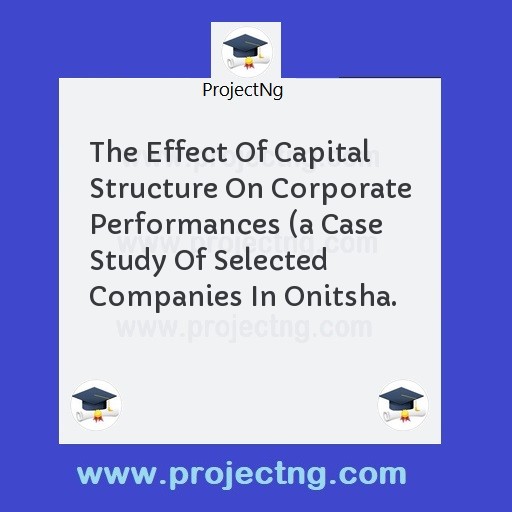The Effect Of Capital Structure On Corporate Performances (a Case Study Of Selected Companies In Onitsha.
Accounting Project Topics
Get the Complete Project Materials Now! »
THE EFFECT OF CAPITAL STRUCTURE ON CORPORATE PERFORMANCES (A CASE STUDY OF SELECTED COMPANIES IN ONITSHA.
ABSTRACT
This study examined the effect of capital structure on corporate performance with reference to selected companies in Onitsha, Questionnaires and interviews were used to collect information from the selected companies in Onitsha, Anambra State. Analysis and observations were made which gave rise to the validity of the conclusion at the end of the analysis, the major finding were:
1. That these is a relationship between capital structure and cost of capital.
2. That capital structure have significant effect on corporate performance (in terms of profitability)
3. That there is a high cost of capital which hinders the companies borrowing ability.
The recommendations for the study among others were:
1. That companies should increase their efficiency in use of debt capital.
2. That since cost of borrowing is so high, if a firm should be able to service fixed charges associated with senior securities and leasing, it can borrow.
3. That for improved performance mostly on profitability, the optimum combination of fund from varying sources which is superior to any alternative combination is necessary.
The researchers then concludes that:
1. The inability of many companies to adopt optimal capital structure has been increasing their cost of capital.
2. Due to increase in the cost of capital for may firms, they were unable to borrow in order to meet up their capital investment hence the decrease in their performance mostly on profitability.
3. The optimal capital structure is one in which the marginal real cost (the sum of both explicit and the implicit costs) of each available method of financing is the same.
TABLE OF CONTENTS
Cover page
Title page
Approval page
Dedication
Acknowledgement
Abstract
Table of content
CHAPTER ONE
General introduction
Statement of the problem
Purpose of the study
Research hypothesis
Significance of the study
Scope and limitations
Definition of terms
References
CHAPTER TWO
Literature review
Introduction
The concept of capital structure
Security valuation
Review of previous studies
Theoretical foundation
References
CHAPTER THREE
Research design and methodology
Sources of data
Primary data
Secondary data
Scope and limitations
Population size
Data treatment and analysis
References
CHAPTER FOUR
Data presentation and analysis
Questionnaires analysis and presentation
Data analysis and presentation
Test and prove of hypothesis
CHAPTER FIVE
Summary, recommendation and conclusion
Summary of findings
Recommendations
Conclusion
Definitions of terms
BIBLIOGRAPHY
APPENDIX.
CHAPTER ONE
1.1 GENERAL INTRODUCTION
A Corporation, Private or Public need capital to enable it achieves its objectives. Capital structure implies the nature and proportion of elements, which go to make up the capital invested in a business corporations that are in need of funds exchange their financial instruments for the money provided by the intermediaries or direct from savers. This money the corporations convert to tangible assets as building, land, plant and machinery, motor vehicles etc. Basically, a corporation uses three main sources of long term and permanent financing viz: common stock, preferred stock and debt financing (bond). It is the combination of these finances to particular firm that is termed capital structure.
There is need for reasonable balance of different types of securities comprising the capital structure of a firm otherwise the firm will deplete its financing ability or finance at sub optimal cost. In achieving this, the cost of capital is important for it has a major impact on the investment decision and the financing structure of the firm of which affect the riskiness and size of the firm. Specifically, the issue has been on whether or not financial leverage effects the firm’s cost of capital, its value and profitability, hence its corporate performance.
Two major schools of thought (the Traditionalist and Modigliani Miller) extreme views on the issues in question have been among those involved in the arguments. According to Modigliani and Miller, in their proposition which states that “the market value of any firm is independent of its capital structure and is obtained by discounting its expected return at a rate appropriate to its risk class”1 in their proposition 2 however, it states that the cost of equity is equal to the cost of capital of an unlevered firm plus the after-tax difference between the cost of an unlevered firm and the cost of debt weighted by the leverage ratio2. Their long standing and unresolved opposite views have become so controversial that it has led many into concluding that the literature is marked by serious confusion and contradictions. This particular notion is manifested in the words of LINTER “the decision rule which have been proposed for determining the optimal capital structure and reliance on different
Be the First to Share On Social

Enjoying our content?
Don't miss out on new videos! Subscribe to our YouTube channel for more awesome content.
Subscribe Now!













